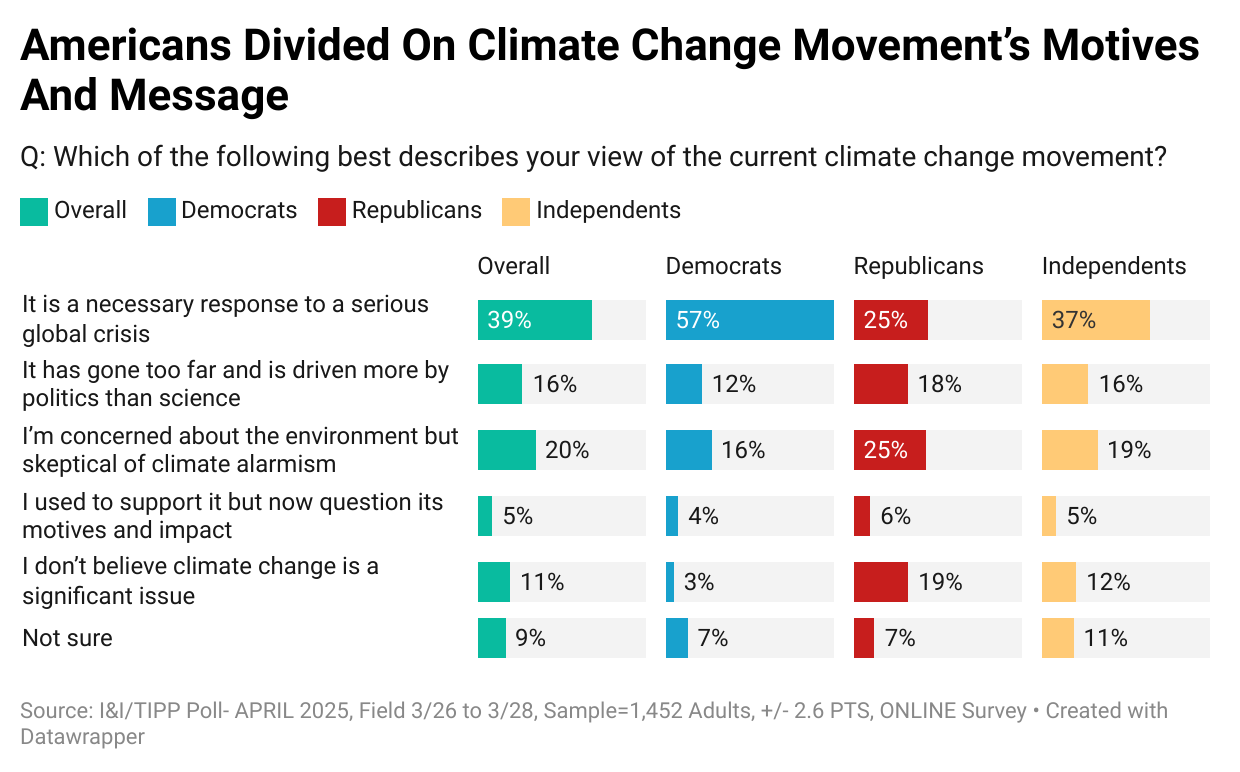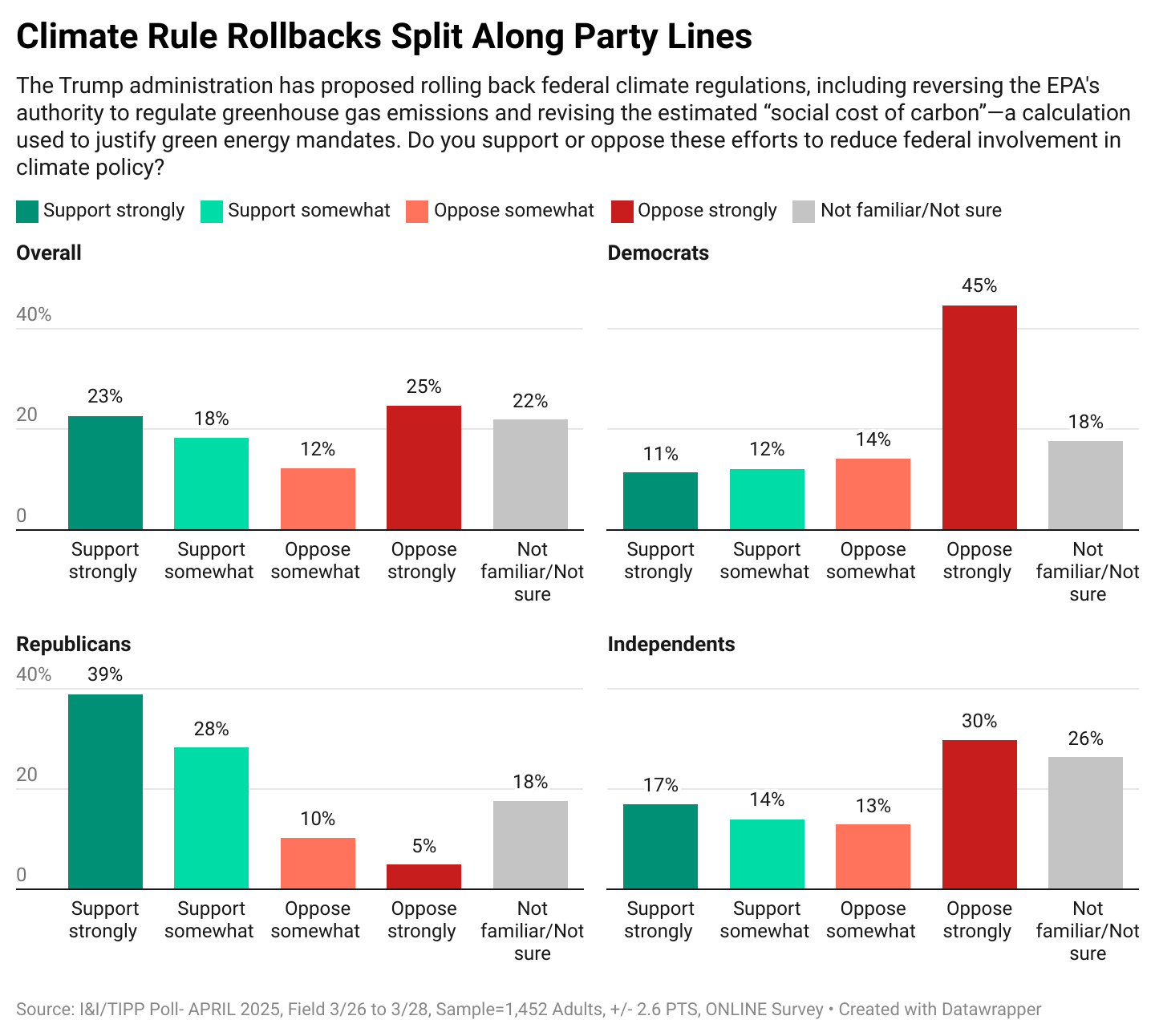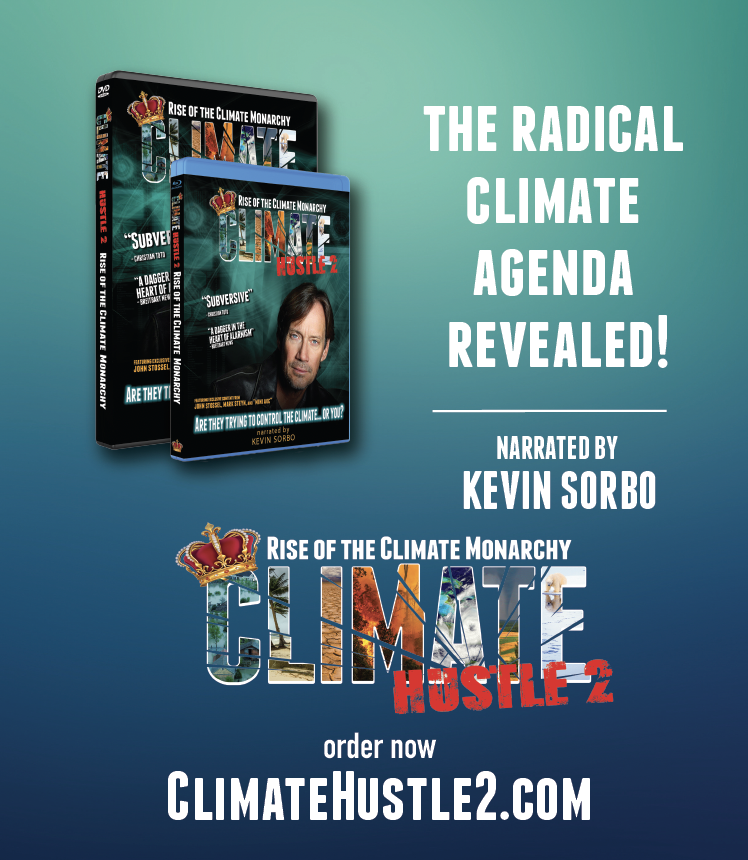I&I/TIPP Poll
Is the Green Movement Dying, If Not Already Dead? It Sure Looks Like It’s Trending That Way.
Excerpt:
What looked like the Green Movement’s unstoppable momentum has stalled out recently, as Americans rethink the costs of some of the more draconian proposals to rid the world of industrial carbon dioxide. As skepticism grows, the movement to slash CO2 at all costs also may be nearing an end, the latest I&I/TIPP Poll shows.
Americans have become increasingly wary of the “net zero” and other modern-day green movements after so many of their doom-filled prophecies of imminent environmental disaster failed to come true.
In its national online poll taken Mar. 26-28, I&I/TIPP asked 1,452 poll respondents the following opening question: “Which of the following best describes your view of the current climate change movement?”
Those taking the poll, which has a +/-2.6 percentage point margin of error, were asked to choose from six possible answers:
The first answer was that the climate-change movement “is a necessary response to a serious global crisis.” It garnered 39% support, more than any other single response.
However, taken together, the remaining five responses portray a broad range of skepticism of the green movement among the rest of those who took the poll.
Within this group, 16% said “It has gone too far and is driven more by politics than science,” while 20% agreed: “I’m concerned about the environment but skeptical of climate alarmism.” Another 5% said “I used to support it but now question its motives and impact,” and 11% noted “I don’t believe climate change is a significant issue.” The remaining 9% said they were not sure.

So a majority (52%) expressed different degrees of skepticism about the climate-change movement, its motivations, its impacts and its significance for the future.
But within the demographic breakdown of the data, two large differences emerge.
One is political affiliation. Among Democrats, 57% believe that the green movement is a “necessary response to a serious global crisis,” while just 25% of Republicans and 37% of independents agreed.
Where a respondent lives also plays a major role, with those living in the Northeast (37%), Midwest (33%) and South (37%) far less likely to see the green movement as a “necessary response,” while out west the number was much higher: 50%. The West’s reputation for green-inflected politics, it seems, is well deserved.
In a second question, I&I/TIPP posed a more concrete policy query of respondents, namely:
“The Trump administration has proposed rolling back federal climate regulations, including reversing the EPA’s authority to regulate greenhouse gas emissions and revising the estimated “social cost of carbon” — a calculation used to justify green energy mandates. Do you support or oppose these efforts to reduce federal involvement in climate policy?”
This time, a plurality of 41% of those answering said they either “support strongly” (23%) or “support somewhat” the “rolling back” of stringent federal climate rules. But not too far behind was the 37% of Americans who said they either “opposed strongly” (25%) or “opposed somewhat” (12%) any weakening of climate regulations.
Ideology, as often the case, plays a big role.
Seventy-percent of those who self-describe as “conservative” support weakening federal environmental rules, with just 14% opposed. Self-identifying moderates, meanwhile, give 29% support, but 45% opposition, to the easing of green laws. And those who call themselves liberals show just 24% support, but 63% opposition to the idea.
Similar splits were seen by party affiliation, as the chart below shows.

So is the green movement dying, if not already dead? It sure looks like it’s trending that way.
Ever since President Donald Trump pulled the U.S. out of the so-called Paris Agreement, the global deal to slash CO2 output, the net-zero movement has hit on hard times. This is the second time Trump has withdrawn from that deal.
Why did Trump leave again? The reason is the same as before. In 2017, a study showed that the Paris Agreement was a horrible deal for the U.S.
“The cost to the economy at this time would be close to $3 trillion in lost GDP and 6.5 million industrial jobs, while households would have $7,000 less income and, in many cases, much worse than that,” Trump said.
If anything, those numbers have gone up. Meanwhile, Trump is transitioning back to U.S. reliance on natural gas and crude oil, which are far more reliable and less expensive than the supposedly green alternatives, such as solar and wind power.
The shift in sentiment in the U.S. has been brutally swift.
“Voters last November rejected the grandiose plans of the Biden Administration to abandon gasoline- and diesel-powered engines, natural gas hot water heaters and other appliances, and coal- and gas-fired power plants,” writes Duggan Flanakin on the Real Clear Energy website. “But who foresaw the total reversal of the anti-business regulatory climate of the past fifty years?”
Americans have experienced brownouts and blackouts, watched their utility and other energy prices soar, while also worrying about the reliability of future supplies of energy. This is bad for the economy, and has fueled a growing political backlash in Washington, D.C., and even some state capitals against the stringent environmental rules that have governed America’s economy for nearly half a century.
By whatever name it goes by, the climate change movement is no longer possible.
“Since taking office, President Donald Trump has pulled the U.S. out of the United Nations Paris agreement on climate change, unleashed fossil fuel production, cut climate subsidies that were part of the Inflation Reduction Act, and chosen as his Secretary of Energy an oilman who helped create the fracking revolution,” wrote author Michael Shellenberger, in a widely shared post on X.
He added: “Given that Democrats have spent the last 20 years describing climate change as an ‘existential threat’ and making climate policy their highest priority under Biden, one would expect there to be significant protests and other actions by progressives.”
So far, that hasn’t happened. The expected blowback to Trump’s environmental moves has been weak at best.
Maybe that’s because businesses are no longer lining up behind such a costly “transition” that now seems uncertain. It’s been a very bad investment.
“(A)fter $9 trillion globally over the last decade spent on wind, solar, electric vehicles, energy storage, electrified heat and power grids … the renewable share of final energy consumption is slowly advancing at 0.3%–0.6% per year,” noted Michael Cembalest, J.P. Morgan’s chairman of market and investment strategy in a recent paper.
Virtually no gains. So it’s been a bad investment all along.
In still another recent report, H. Sterling Burnett, the Heartland Institute’s director of the Arthur B. Robinson Center on Climate and Environmental Policy, summed up what’s happened in just a few months: “(W)ith Donald Trump returning as president, big banks, investment houses, and fund managers have begun to see the writing on the wall and have started withdrawing their support for multilateral and domestic climate goals and efforts to end fossil fuel use.”
That also includes Big Tech firms, which were all in on the green revolution until they realized that renewables would never be able to satisfy their soaring need for energy to power their massive artificial intelligence server farms.
Like it or not, the energy world is changing. The U.S. is moving back toward its strength, carbon-based fuels, and away from hyper-expensive “green” substitutes. As the I&I/TIPP Poll this month shows, most Americans will be just fine with that.
I&I/TIPP publishes timely, unique, and informative data each month on topics of public interest. TIPP’s reputation for polling excellence comes from being the most accurate pollster for the past six presidential elections.
Terry Jones is an editor of Issues & Insights. His four decades of journalism experience include serving as national issues editor, economics editor, and editorial page editor for Investor’s Business Daily.


